|
– Page 2 of 3 –
THE FILMS – 6-10 (+1)
| SHOULD MARRIED MEN GO HOME? (1928) |
|
In a turnaround twist on the home situation of Their Purple Moment and following a title card that suggests that the best way to keep a husband at home is to break both of his legs, Ollie is here presented as a happily married man who is looking forward to finally being able to spend a quiet Sunday in with his loving wife (Kay Deslys, who played his extra-marital date in the previous film). Just as the two are cuddling up on the sofa, however, Ollie’s wife (the female characters still don’t have names) spots the presumably unmarried Stan striding towards the house dressed in golfing clothing and carrying a bag of clubs. The couple respond by moving hurriedly and quietly away from the window and pretending that they’re out, which doesn’t stop Stan repeatedly hammering on the door, first with his fist and then with one of his weightier clubs. It’s then that we get an prime example of what would become a treasured Stan and Ollie trope, which for the hell of it I’ll call the logical illogical statement (other examples being the twice used “If you must make a noise, make it quietly” and Stan’s most celebrated proverb, “You can lead a horse to water but a pencil must be lead”). The one here takes the form of the note that he leaves for Ollie, which states, “If you’re not in when I come back I’ll know you are out.” He shoves it partially under the door, and is just about to leave when he sees it being pulled inside by a careless Ollie, a move that confirms that he is in after all.
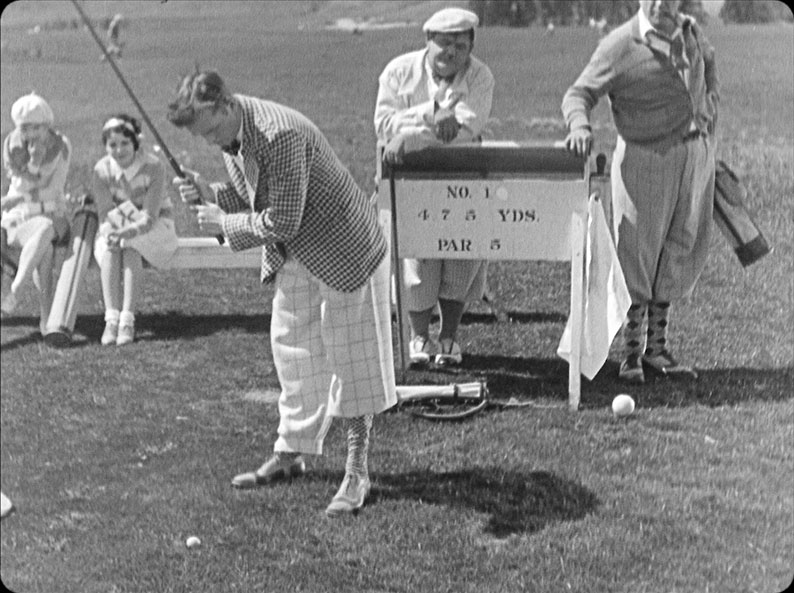
What follows is a sequence that genuinely wound me up, as the dozily unaware Stan completely misinterprets Ollie’s statement that he and his wife plan to spend the day indoors as an invitation to join them. This results in an excruciating shot in which Stan sits on a chair looking dozily into space, completely oblivious to the wishes of his supposed friend, while Ollie stares accusingly at him from the sofa and his wife looks off to the side with the posture and expression of someone deeply uncomfortable with the whole situation. Having experienced this myself more than once, I really wanted to give Stan a resounding slap. The awkward silence is broken when Stan asks if he can play the gramophone, but after he wrecks a window blind and destroys a chair whilst attempting to reach it, an exasperated Ollie insists on operating the machine instead, prompting it to spring apart like a wildly malfunctioning jack-in-the-box. By this point fed up with them both, Ollie’s wife angrily tells her husband go and play golf with Stan after all, which he curiously seems to be already dressed for under his robe. When the two men reach the club, however, they are greeted by the news that only parties of four are being admitted today (seems a bit random, but what do I know?), and wouldn’t you know it, there are two pretty young ladies (Edna Marion and Viola Richard) who are upset that they will also be refused admission as a result. It’s then that they spot Stan and Ollie and start smiling cutely at them…
What follows is a string of golf-related gags, several involving a lone golfer (Edgar Kennedy), who I assumed has become separated from the three companions he would have needed to gain entry to the club today. Director James Parrott gets cinematically adventurous at one point with a minute-long tracking shot ahead of Ollie, Stan, and their new female companions as they walk across the golf course and Stan picks up every ball he sees on the assumption that they have been discarded, and a whole string of confused golfers wander into shot behind them looking for the balls that they were certain that they hit there. It peaks in a sequence of mud-throwing pandemonium, a sort of smaller scale and grubbier version of the climactic pie-fight in the 1927 Battle of the Century, and the revelation that even golf courses in Hal Roach comedies had pools of muddy water a couple of metres deep that exist solely for characters to walk unexpectedly into.
Having locked down the style and characters with which they would achieve international fame in their preceding films, here the Stan and Ollie formula is unexpectedly disrupted for a film that leans towards their earlier more slapstick oriented work and seriously messes with their established on-screen relationship. That said, it certainly starts in classic Stan and Ollie fashion, with the two men sitting on a park bench with their dog Buster at Stan’s side, as Ollie fastidiously opens a letter and hands the disposable portions to Stan, who then passes them to Buster, who drops them in a bin that is within Stan’s easy reach. When Ollie finally gets to the letter itself, he learns that he’s been left a fortune by a rich uncle, which initially has Stan on the verge of tears as he wonders what will become of him now, only for Ollie to offer to employ him as his butler, an arrangement that instantly brightens Stan’s mood.
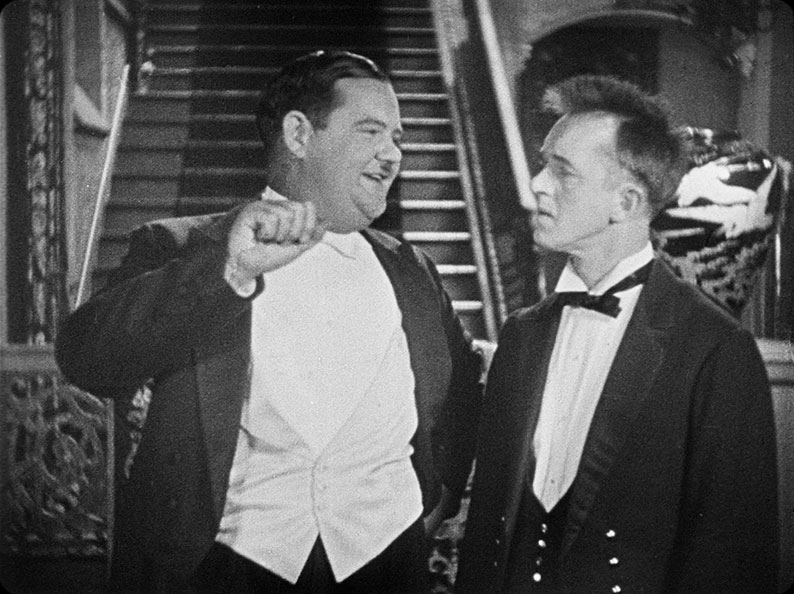
Knowing the boys, you might think that you could guess where this is heading, as the pompous Ollie’s attempts to impress the members of high society is undone at every turn by the well-meaning Stan’s bumbling, but that’s not how it plays out after all. Our introduction to Stan in his new role has him proudly placing a cake that he has baked for Ollie’s birthday on a table, and the surprise is that none of the gags being telegraphed here play out as expected. When Stan tastes the cream that tops the cake, his slow break into a satisfied smile had me convinced that he’d go back for another taste, and another, and another until the cake was ruined, but this just doesn’t happen. Similarly, when he looks down, Buster is standing on his hind legs in a begging pose, and the fate of the cake once again seemed sealed, but expectations are once again confounded when Stan picks Buster up and carries him through to his bed and orders him to stay put, which he obediently does. Stan then nips into the courtyard to fill Buster’s bowl and I began to wonder if this film was a previously lost work by Spanish surrealist Luis Buñuel. Located in the courtyard is fountain that will haunt my nightmares, one whose water pours from the mouths of a ring of disembodied Oliver Hardy heads. When one them falters, Stan hits it with the bowl to get it working again, laying the groundwork for an inevitable later sequence that this time does con form to expectations.
It's when Ollie arrives home in a cheerfully drunk state that the team’s now established comedy formula is turned on its head. Instead of Stan playing the bumbling child to Ollie’s pompous and overconfident adult, Ollie behaves like a mischievous kid who just won’t go to bed as ordered, instead amusing himself by playing tricks on Stan, ruffling his hair, pulling open his bow tie, spraying breath freshener in his eyes, and eventually wrestling him to the ground. When he finally agrees to go to sleep, Stan retires for the night, only for Ollie to then enter his room to show him his new spring outfit, and when Stan refuses to respond, Ollie slowly pours an entire jug of water into his bed, laughing uproariously as he does so. This, for Stan, is the final straw, and he announces that he will be leaving the following morning, but Ollie has no intention of letting him go, prompting Stan to start taking action to get himself fired instead. Cue five minutes of destructive chaos.
After the style establishing Their Purple Moment and Should Married Men Go Home?, Early to Bed is something of curio, a continuity stutter on the duo’s road finalising the personalities and the relationship that they had been so carefully cultivating, seemingly to explore a different dynamic and see how it played out. There are still a couple of signature Stan Laurel moments here, in the slow shift of expression from concern to satisfaction when he tastes the cake, and in his facially scrunched-up collapse into tears when things go badly for him, though this quickly stops being funny here and slips into pathos. There’s precious little trace of the Ollie that we came to adore, no moments of realisation and long-suffering looks at the camera, just a relentless bullying of Stan for his own rollicking amusement, the sort of abuse of power and position that we see too in the real world today to be all that amused by. The expected and telegraphed gag involving that creepy fountain is played out for all it’s worth, and the somewhat pat way in which the film ends does seem to reaffirm that, in spite of their new master and servant roles, it’s their longstanding friendship that keeps these two men together.
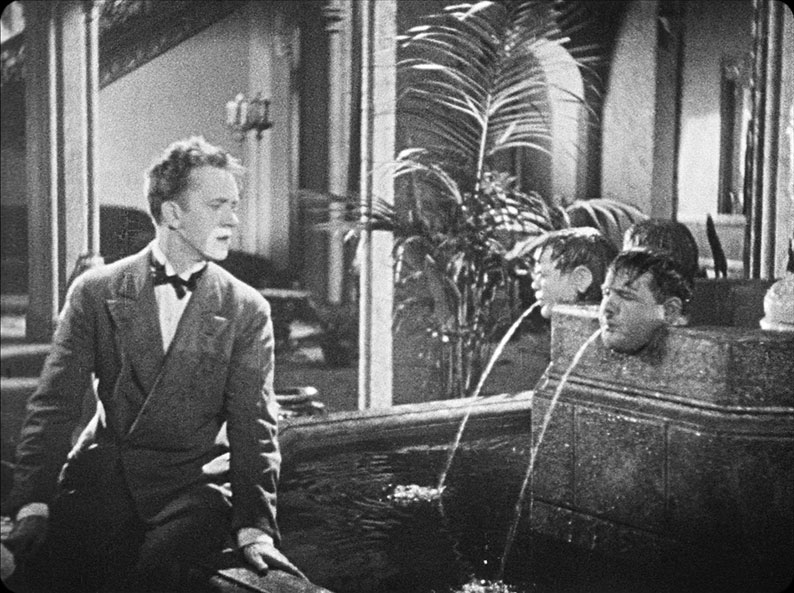
Not my favourite work in this set, but an intriguing and technically well-constructed one – a gag involving a leaping dog that I presume cuts between the real animal and a fake one is impeccably edited, and there’s a terrific bit of physical comedy that sees Ollie just manage catch a large vase that Stan has deliberately toppled, only for Stan to then return and slyly finish the job after Ollie has placed it back on its pedestal. There’s also a moment in the fountain finale where Stan responds to a sound one of the fountain-heads makes when he hits it, an audio response that is visually communicated. That said, the less said the better about the archaic suggestion that Stan would be able to date an attractive maid if only she wasn’t Chinese.
Now we’re talking. Disc two begins with a silent Stan and Ollie classic in which the boys play two sailors on leave, and begins with them happily tootling around town in a newly rented car. What could possibly go wrong? Ollie takes over driving after Stan almost runs over a pedestrian (Sam Lufkin), and whilst lecturing him on the importance of keeping your eyes on the road he runs straight into a lamp post, an embarrassing and attention-drawing accident from which they hastily move on. When they pull up at the kerbside a short while later, they spot two attractive young women (Thelma Hill and Ruby Blaine) struggling with a shopfront gumball machine, and in an attempt shake the blockage loose, Ollie sprays its contents all over the sidewalk. As the others wait in the car, Ollie grabs a few gumballs from the pavement and stuffs them down his shirt, a theft that is halted when the unamused shopkeeper (Charlie Hall) emerges and physically assaults him and Stan, only for the girls to march over and give the shopkeeper what for. The four then head off together, but soon they find themselves caught in a traffic jam caused by a car at the front running out of fuel, and a failed attempt to pass it results in them being rear-ended by the car behind them.
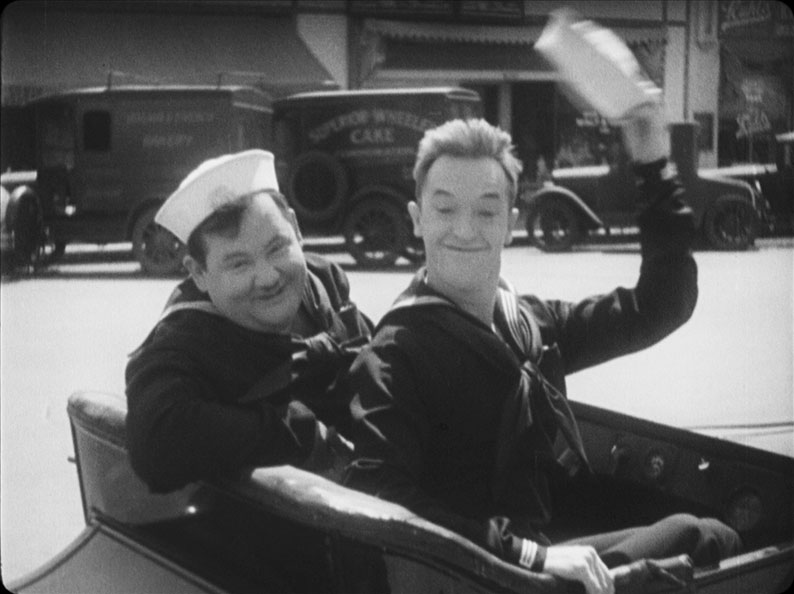
All of this is a first-half build-up to one of the defining intertitles in this whole set, when one of the aggrieved women says to Ollie, “Are you going to let that bozo bump our car?” This kicks off an orgy of steadily mounting tit-for-tat destruction involving vehicles whose bodywork can be pulled apart with your bare hands and whose wheels can be yanked off with little more than a sharp tug. The characters that Stan and Ollie had established before the experimental blip of Early to Bed are back in full comical force here, as are several of their defining behavioural characteristics. A favourite comes when Ollie insists on taking over the driving, convinced as ever that he is more able to carry out the task than his companion, only to then demonstrate that he is anything but, while the hilariously prissy manner in which he holds the steering wheel with his fingertips a fully formed sound-era Ollie mannerism. When the two realise they’re being eyed-up by the women, both react with exaggerated bashful “aw shucks” smiling shyness, and the fact that the women prove to be tougher and more fearsome than their hapless male counterparts would become a trait of Stan and Ollie films. Casting continuity is provided by regulars Charlie Hall as the angry shopkeeper and a moustachioed Edgar Kennedy as the driver whose dispute with Stan and Ollie really kicks things off, and that favourite Stan and Ollie gag of having someone just stand indignantly whilst their heads, bodies or clothes are despoiled, reacting to it only when the assault is complete, is on full display here as well.
The tit-for-tat conflict that erupts in the second half is effectively a ten minute set-piece and one of the most elaborate (and, I’ll wager, expensive) in Stan and Ollie’s silent film oeuvre, with brief moments of destruction requiring the sort of prep that would normally be reserved for a medium budget action movie. Cars had to be rigged with parts that could be pulled off, smashed or bent spectacularly out of shape, and in one of many laugh-out-loud moments, Ollie gives one irate driver such a hard shove that he impacts the side of his car with such force that it knocks the vehicle instantly onto its side. The fighting is eventually brought to a halt and the cars moved on by a motorcycle cop (Edgar Dearing) whose bike is squashed flat by one of the heavier vehicles (one of the rare times a road roller is not the culprit) and what follows is even funnier than the destruction itself, the parade of creatively damaged and distorted cars – which include one that prefigures the foot-driven cars of The Flintstones – that trundles past the camera suggesting that the props department were handed a bucket of cash and told to have a field day. Even then, one of the things that still tickles me the most is that for the second half Stan and Ollie has swapped hats with their dates and act all tough with the other motorists whilst sporting rather fetching womens' bonnets.
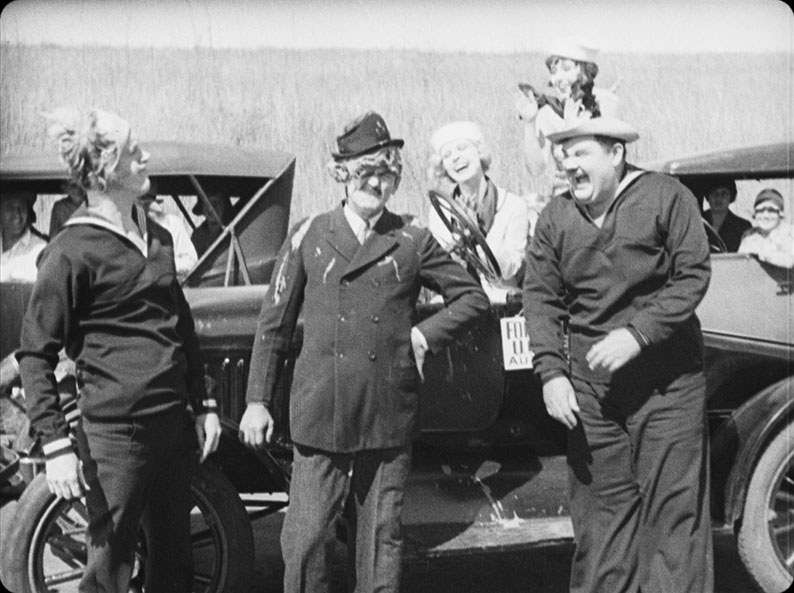
As well as being one of Stan and Ollie’s finest and funniest films of their period, Two Tars has a special place in my heart as the first silent Stan and Ollie film I saw in its entirety when it played on the big screen at the first of two Laurel and Hardy festivals I attended at the Scala Cinema in London back in 1980. It went down a storm with the audience of Laurel and Hardy fans, and was previewed in what I believe was London listings magazine Time Out (apologies to the writer if I’ve got this wrong) with a tantalising article that opened with above-quoted line of dialogue and went on to describe the film as “two reels of perfect joy.” Enough said.
Eccentric scientist Professor Padilla (Richard Carle) is expressing his need one dark evening to procure a subject to prove a suspect theory regarding the smoothness of the human brain when who should knock at his door but Stan and Ollie, down on their luck and wondering if Padilla household could spare a piece of buttered toast. The delighted Padilla invites them in and offers them $500 if they go to the graveyard and bring him back a body this very night. Despite the professor’s oddball habit of using his waistcoat pocket as an ashtray, Ollie accepts on the duo’s behalf and he and Stan head nervously towards the cemetery, unaware that Padilla’s butler is an undercover cop named Ledoux (Charley Rogers), and that the professor is as mad as a box of frogs. After the cheerfully untroubled professor is arrested and carried off to the asylum, Ledoux actions an order from his superior (Leo Sulky) to follow Stan and Ollie and presumably stop them from carrying out their grim nocturnal task. I say presumably because this should be a piss-easy job for a detective, who could simply march up to the boys, flash his badge and either arrest them or send them on their way with a flea in their ear. But that’s clearly too boring a solution for our Ledoux, who instead grabs a white sheet and hides in the graveyard, where he misses no opportunity to frighten the already rattled Stan out of his wits, seemingly for his own twisted amusement.
Effectively an expansion on a single scene in the 1927 Do Detectives Think?, this cheerful amble into the then still young comedy-horror subgenre is a fun mix of spooky gags and extended slapstick tomfoolery, much if it very much in the Stan and Ollie mode. Logic is occasionally put on hold to deliver a gag – what possible reason could there be for putting a “Wet Paint” sign at the top of instead of the base of a newly painted telegraph pole? – but setting the film at night and having the boys scared of their own shadows provides plenty of opportunity for character-based laughs. Their talent for squeezing as much mileage as they can from a single gag is taken close to its limit in a sequence that sees Ollie trying repeatedly to help Stan over the cemetery wall, first by cupping his hands (which Stan initially mimics) to give him a leg-up, then by getting down on all fours and allowing him to climb on his back, and finally by pushing him up and getting Stan’s feet planted roughly onto his head and face. If Ollie didn’t come away bruised and battered from filming this scene I’d be genuinely surprised. There’s a gag involving Ollie’s toes that was later repurposed in the duo’s 1934 short Oliver The Eighth (another excellent horror-comedy), and it’s also Ollie who delivers the moment that made me laugh the loudest when he attempts to scale the cemetery wall unassisted and… ah, you’ll have to see that one for yourself. We’re also treated to a couple of the duo’s signature routines when they briefly lose and then mix up their hats, and later when Ollie steps into a puddle that’s a couple of metres deep.
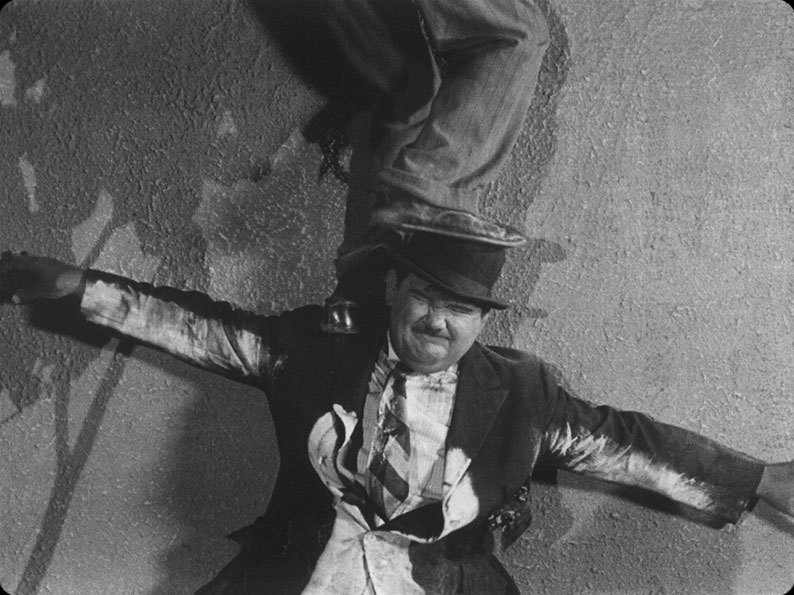
Highly enjoyable on its own merits, Habeas Corpus is a key film in Stan and Ollie’s filmography, as although still technically a silent film (there is no recorded dialogue, and lines are still delivered as intertitle text), this was their first film with a synchronised soundtrack, which has also been restored and is included here. Primarily this consists of a music score that draws on several thematically dark classical favourites, including Frédéric Chopin’s Marche Funèbre, Camille Saint-Saëns' Danse Macabre, and Charles Gounod’s Funeral March of a Marionette, which later became more widely known as the theme tune for the TV series Alfred Hitchcock Presents. A selection of sound effects has also been added, mainly bumps, knocks and other sounds of collision and a few perfectly synchronised handclaps, as well as a musically produced eerie wind. At this point, the boys had yet to find what would become their now famous theme tune, The Dance of the Cuckoos by Marvin Hatley, which would be used first on both the 1930 Blotto and the Spanish language version of the same year’s Night Owls.
Stan and Ollie are once again married to attractive but deeply suspicious and controlling wives (Vivien Oakland and Bess Flowers) in a story outlined with just a whiff of sarcasm by regular intertitle writer H.M. Walker as one “based upon the assumption that, somewhere in the world, there are husbands who do not tell their wives everything.” In Stan and Ollie’s case it’s that they had planned to take part in a poker game, an activity that we can presume that their card-playing wives would object to. When a call is put through to the house on the other poker players’ behalf to ask where they’ve got to, Ollie pretends that it’s his boss inviting him and Stan out to the Orpheum Theatre, a story that both wives clearly have their serious doubts about.
On their way to the poker game, Stan and Ollie encounter two women (Kay Deslys and Vera White), one of whose hat has blown under an adjacent parked car. Whilst pushing the vehicle forward to retrieve the bonnet, both men fall on their faces and are soaked by the hose of a passing road cleaning vehicle, and as a result are invited by the bonnet’s owner back to her apartment to dry their clothes. Now dressed in the underclothes and borrowed bathrobes, Stan and Ollie sit and cheerfully converse with the two flirty women, unaware that the one whose apartment they are in is the girlfriend of a burly prize fighter named One-Round Kelly (George Kotsonaros). They are also unaware that a fire has broken out at the Orpheum Theatre, news of which reaches their wives (via a newspaper that must have been written up, typeset, printed and distributed in less than an hour), who head to the theatre to check on their husbands. In a most unfortunate piece of timing they just happen to be passing the One-Round Kelly’s girlfriend’s apartment as the boxer arrives home and the boys are beating a hasty retreat through the bathroom window, waving goodbye to the women and pulling their freshly dried clothing on as they leave.
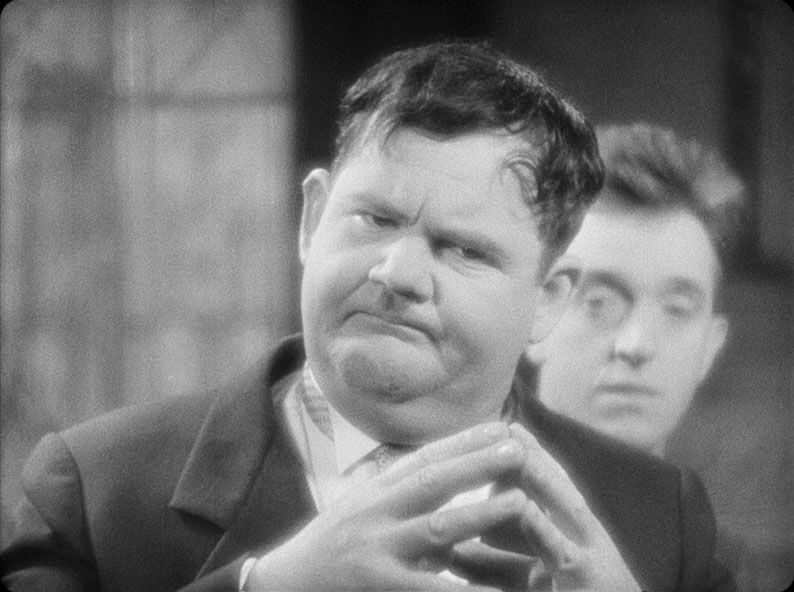
A film that just couldn’t have been made once the Production Code put its censorial stamp on American cinema, this suggestive comedy of wrongly perceived infidelity continues to push the envelope on (potentially over-) extended gags once One-Round Kelly’s girlfriend takes a shine to Stan. Having made her laugh uproariously with his oddball bodily responses to her pokes and prods, and encouraged by Ollie to “be Bohemian” and “make whoopee,” Stan gets into a borderline violent shoving match with his new female admirer, which somehow amuses the hell out of her and only encourages her to continue coming on to him. Only when he claims he doesn’t like her because she’s fat does she suddenly and understandably lose her sense of humour, and it’s as Ollie is attempting to calm her down by putting a comforting arm around her that her boxer boyfriend enters the apartment.
Cinematically, this is one of the most interesting films in this set, with director Leo McCarey and regular cinematographer George Stevens giving the duo more close-ups than normal, including a sublimely framed shot of Ollie in which Stan is positioned just out of focus over his shoulder. They even use framing and camera position to put off a superb reveal, when Ollie, who seems to be alone on the sofa in a state of agitation, sits back to reveal that Stan is sitting calmly beside him and smoking a pipe. It all builds to a sublimely archetypal Stan and Ollie scene that has Ollie is put on the spot by the two wives, who demand that he tells them all about a show that they know full well that he and Stan did not attend. As he struggles to come up with a convincing story, the two women sit on the sofa sternly glaring at him, while Stan sits behind them miming suggestions to Ollie that he repeatedly misinterprets. It’s a riotously funny sequence that climaxes with in moment of threatened cartoon violence, which would become a Stan and Ollie favourite, as Ollie’s wife grabs a shotgun and chases the boys out of the house and down the road towards a superbly executed and surprisingly large-scale pre-code closing gag.
| NOW I’LL TELL ONE (1927 – incomplete) |
|
Only the second half of this 1927 Charley Chase vehicle in which Stan and Ollie have supporting roles has survived, and if you arrive at the midway point without any knowledge of the story, as I did, be ready to wince in disbelief. But stay with it, as not all is as it initially seems. After an amusing gag in which Charley fires a gun into a telephone receiver, only for the bullet to shoot out of the earpiece, an agitated policeman (Oliver Hardy) enters the house and demands to know what the hell is going on. “I’m getting ready to shoot my wife!” Charley tells him as the woman in question (Edna Marion) makes a hopeful plea to the cop, who smiles widely and says to Charley, “Pardon! I thought it was something serious!” and departs. Given how many women over the years have suffered physical abuse or worse, in part because the police refused to take their claims seriously or sided with the abuser, I couldn’t help baulking a little at this. But that’s exactly why context is so important.
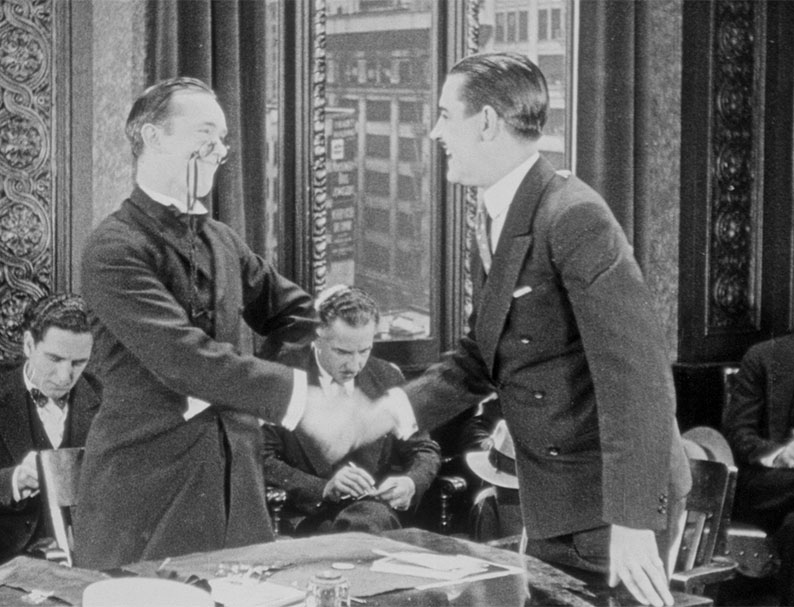
As what the film progresses, it becomes evident that this is a story being told by the wife to the judge in a divorce court, a hearing in which both she and her husband have been spinning wildly exaggerated yarns about their relationship in order to make themselves out to be the victim of outrageous treatment by their partner. This first becomes clear when the wife recalls slaving in the washroom of their house like a Cinderella servant girl, while enough bedsheets to serve the inhabitants of a small town hang on the dizzying number of lines in their field-sized yard. She pauses only briefly in her work to put a light in the window as a guide for her husband, who is stumbling home at some ungodly hour in a woefully drunken state. Stan plays the husband’s lawyer, and unsurprisingly is about as much use as a chocolate teapot, successfully challenging the wife’s claim that she was shot through the heart by asking how she could be alive if this was the case, then offering up a possible explanation that she immediately seizes on and that has the husband screaming in frustration.
I’m guessing that the first half consisted of the husband’s equally tall tales of his wife’s behaviour, and I’d love to have seen this, as the half that has survived is most wittily executed, not least for Chase’s amusingly choreographed drunken stumbling and the eye-watering sincerity of Marion’s devotion to her endless housework. The invented story within a story structure allows director James Parrott to ignore continuity if the fancy takes him (night switches to day in a heartbeat here) and deliver some impeccably handled visual gags that make no real world sense. My favourite of these has Chase skipping over shadows cast across the road by telegraph poles, then disappearing down a deep, shadow-shaped hole in the tarmac on the one time that he omits to do so. Incomplete this film may be, but it’s still a most welcome inclusion.
|